
Co-Creating Collective Benefits
Through our work with small-scale and community forests we have learned that we need to embrace complexity and find ways for producing enabling market conditions. A proven way of finding mutually beneficial, or collective, benefits is the collective impact model. Collective impact is a proven model, initially devised by the Kennedy School at Harvard and published by Stanford Social Innovation Review in 2011. It proposes the joint commitment of a group of actors from different sectors to a common agenda for solving a specific problem with relevant social dimensions. In order for the commitment to be successfully achieved, five criteria must be secured:

So, rather than focus efforts on local value chain strategies, the adoption of collective impact would seek a process grounded in a systemic approach.

We have been implementing this model in three separate countries in Latin America. Read the updates in the briefing note to learn more and understand our goals for pursuing the collective impact approach.